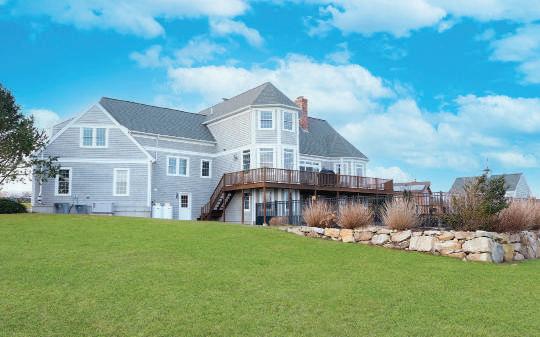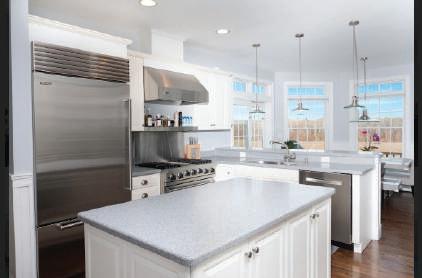HomesEAST BAY
Snuggle up with our Real Estate insiders

n 10 tips as you prep to sell
n The ‘Wild West’ market continues
n Why it might make sense to rent
n Even now, you can pre-game for spring
n See all the high sales of 2021











Snuggle up with our Real Estate insiders

n 10 tips as you prep to sell
n The ‘Wild West’ market continues
n Why it might make sense to rent
n Even now, you can pre-game for spring
n See all the high sales of 2021










Although the real estate market continues to be insanely competitive, property owners should be mindful of tried-and-true rules that still apply when getting a house ready to sell.
Homeowners who are not sure how to begin to tackle such a daunting task would do well to embrace the philosophy espoused by author and organizing guru Marie Kondo. When prospective buyers drive up to your home and walk through the door for the first time, you want to ensure the experience will “spark joy” in their hearts and minds.

The following steps can help to achieve that goal:
First, take photos: You will gain a fresh perspective if you view your home, both inside and out, through a photographer’s lens. It is often surprising how your own photos of each room in the house can instantly reveal what changes are needed and which household items should be rearranged or removed.

Focus on curb appeal: Walk across the street and look at your home as though you are seeing it through the eyes of a stranger. Consider whether a freshly painted front door would be beneficial and study the symbolism of various colors. (For example, a red door is welcoming; blue reflects serenity and calm; and black connotes wealth and sophistication.) Make sure your lawn is well manicured, power wash your house if necessary, and replace your old mailbox. These are just a few examples of budget-friendly upgrades that will create a positive first impression.
Clean everything: A spotless home is essential in creating a sense of tranquility, peace, and order. Deep cleaning checklists can be accessed online. Ask yourself if certain rooms need a fresh coat of paint or if it’s time to remove or replace old wall-towall carpeting. Don’t ignore the basement and garage, which can often become catch-all spaces for unneeded items. Enlist the aid of professionals if necessary.
Declutter: Remove all unnecessary and/or unattractive items on counters, tables, bureaus and other surfaces. Toss newspapers and magazines, and consider donating old books to libraries or thrift shops.
From Page 5
Google the word “minimalism” or listen to podcasts on the topic and be inspired by the countless positive ways your life will be transformed once you have less “stuff.”
Pare down: This can be a painful process for those who have strong emotional attachments to cherished items they have been accumulating for decades. Experts recommend creating a master plan for the job and tackling a room at a time. Enlist the help of non-judgmental family and friends.
Be ruthless in deciding what items are worthy of being gifted, donated, sold, or consigned and which ones need to be trashed. “The Gentle Art of Swedish Death Cleaning” by Margareta Magnusson is a good resource, though admittedly, the title may make you wince.
Organize cupboards and closets: Since some potential buyers will surely be peeking inside these spaces, avoid the temptation to transform them into mini storage units as you
declutter and pare down. Use online resources, bookstores, or your local library to read about the best ways to create order in every room of your house.
Furniture placement is critical: Consider making a floor plan, drawn
Pay attention to details: Often it’s the little things that count. Upgrading switch plates, doorknobs, or kitchen hardware may be exactly what is needed to bring some subtle elegance to an otherwise unremarkable room. Replacing throw pillows, area rugs, and bed linens can have a similar effect.
Bring the outdoors inside: A few lush, healthy houseplants can bring character and life to a room while filling empty corners. Fresh flowers are a charming and affordable way to add pops of color and sweet scents to every room of your house, regardless of the season.
to scale, for rooms you and your family use the most. Using simple cut-out shapes to represent your furniture, have some fun experimenting with different room arrangements while figuring out how to create spaces that are cozy, warm and inviting.
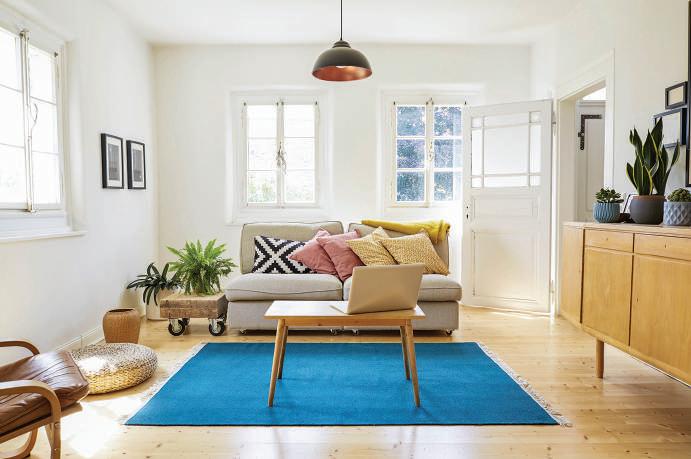
Consider this: Marie Kondo advises her readers to “never discard anything without saying thank you and goodbye.” Keep her words of wisdom in mind as you go through each stage of the process of preparing your home for sale. Soon enough you will have to turn over the keys to new owners, thank your house for the joy it has given you, and say good-bye to it as you walk out the door for the last time.
Whether you’re building a home, buying, or refinancing, our mortgage experts at BankNewport are ready to help:


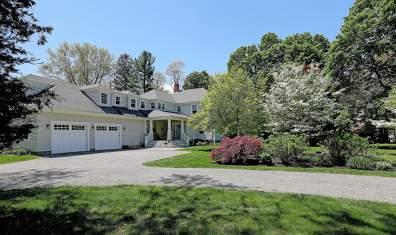





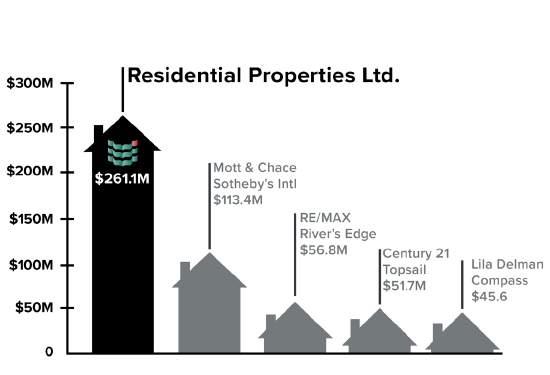

The housing market in the East Bay is tighter right now than it was heading into the hypercompetitive 2021 spring housing market. Unfortunately for home buyers, more heartache, not relief, is the projection for 2022.
As the 2021 market came to a conclusion last year, industry insiders hoped inventory levels would begin to rise. Through the summer and fall, inventory did finally tick up a bit. While the number of homes listed for sale did rise, it hasn’t been enough to make the market friendly for home buyers.

Mortgage rates are climbing as well, creating yet another barrier in purchasing a home. Currently, the average 30-year fixed mortgage rate is 3.62%, up from 2.65% in January 2021.
doesn’t even think the traditional ‘spring market’ exists right now.
“The idea of a spring market went out the door with Covid-19. There is and will continue to be a scarcity in available homes on the market — I believe even more so than last year, which means if you are positioned properly with little competition, you will sell, regardless of snow on the ground or not.

“I think sellers and buyers need to realign their thinking and stop looking for historical facts and figures to predict the market fluctuations and impending ‘drop’. We have been in a wild-west situation, as we enter year three of the pandemic. There is no history for what we are experiencing,” she said.
Often sellers are fielding offers with highest and best terms, which do not include waiting on the sale of a buyer’s home, and in some cases, sight unseen. Home sale contingency offers are not impossible, but sellers need to be positioned properly before entering into the buyers’ market.





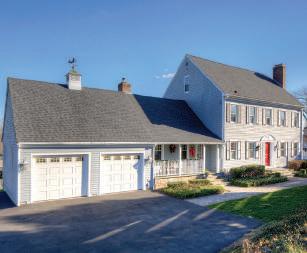








From Page 8
“In the high-end markets, cash still seems to be king, as I am seeing experienced agents putting in over-asking, cash non-contingent offers, effectively raising prices more as we move along. The interest rates seem to have little effect on the high-end markets at this time,” Welchman said.
At lower levels of the market, the same forces remain — low inventory and high demand. Add in rising interest rates, topping out at the highest they have been in two years, and buyers are more desperate than ever to secure the “American Dream” before their buying power drops.
Across all market segments, houses that are perceived to be “move-in condition” are yielding premium prices due to a lack of available contractors, the soaring price of materials and supply chain issues due to Covid-19.
Janet Bausch, of NorthPoint Mortgage in East Providence, said the real estate market is like none she has seen in her long career.

“It’s a mad, mad world, especially if
you are hoping to purchase a home in 2022. It may feel like winter, but the spring market is already upon us. In fact, it arrived in 2021 and never left. One full month into 2022, we’ve already seen some market volatility. As we look ahead at the economy, it’s important to remain on course to achieve your goals over the long-term. We can’t predict, but we can plan,” Bausch said.
She said the outlook for 2022 should continue to be a strong real estate market for buyers and sellers. Rates had fallen to historical lows in 2021 and remained that way throughout the year. Inflation is on the rise, and the Federal Reserve is expected to have several rate hikes during the coming year. Rates increased in January in anticipation of these increases and growing inflation numbers.
Historically, home prices tend to remain stable as rates rise and typically help offset any increase in rates. In contrast to historic trends, with low inventory and high demand, expect more bidding wars.
“Your best defense is a good offense. If you are planning on selling, make sure you get a market analysis and know the average time on the market in your price
range. You will want to know how much you will net from the sale of your home after all expenses are calculated, which will help you plan for a move. If you are buying, make sure you get a complete pre-approval. This will help prepare you for a bidding war,” Bausch said.
Dawn Keys has been renting a home in Portsmouth for many years and is looking to buy a home in Portsmouth, Tiverton or Bristol this spring. Her options are limited in her price range of about $300,000 — although in this market that is better price point than at other levels of the market, relatively

speaking.
“I’m concerned about whether or not I will be able to buy. I am currently working on getting pre-approval, and some of the requirements are tough, as things happen in life that are not planned. The market is high and the reasonable houses sell quickly. I wouldn’t be looking to buy at this time, due to the unreasonable prices, however due to unforeseen circumstances I feel I have no other options. Rent is also at a higher rate and is unsustainable moving forward,” Keys said.
Deb Jobin of RE/MAX River’s Edge said the market in the area is tough on potential buyers.
“Inventory remains very low, making it difficult for buyers. Even with slight increases in mortgage rates the inventory remains low. The $300,000 price range attracts the most buyers. There are often lines of buyers at open houses. Many are making as many as 12 or so offers before they get one that is accepted. To make the offer more desirable, the buyers are opting out of inspections, which is risky for those not as familiar with potential home issues,” said Ms. Jobin.
For over 30 years, with our combined experience in all types of markets, we have grown to specialize in the Senior Real Estate Market. We offer full management services, from start to finish. We put our clients at ease and move at their individual pace and timeline.



“It’s a mad, mad world, especially if you are hoping to purchase a home in 2022. It may feel like winter, but the spring market is already upon us.”
JANET BAUSCH
The appreciation of real estate over time has long made owning a home or an investment property a sound financial strategy.
Prospective home buyers spend considerable time looking for a property they’re hoping to call home. Various factors, including property taxes and the reputation of local schools, may be considered as homeowners decide where to look for a new home. That vetting process is equally important, albeit slightly different, when buyers are consider investing in properties they don’t intend to live in.

Real estate can be a great way to diversify an investment portfolio and earn extra income. Before shopping for an investment property, novice investors may want to consider certain factors to determine if real estate is the best investment vehicle for them.

Location is a significant factor to consider when investing in real estate, but recent shifts in how and where people work could change the real estate investment landscape. A 2020 Gartner, Inc., survey of more than 300
financial executives and leaders in the finance industry found that roughly 25 percent will move at least one out of every five of their on-site workers to permanently remote positions in the years ahead. Economists note that this shift to remote working could be among the more lasting trends to emerge from the pandemic.
Before investing in real estate, prospective investors should examine local trends to see if more and more locals are working remotely, and whether or not that’s affecting the market for rentals.
Forces outside of the real estate market will influence the long-term returns on an investment property — such as remote workforce trends and supplyline renovation challenges.
Flipping properties gained popularity in the second decade of this century, but figures from the property database curator ATTOM Data Solutions indicates that returns on investments in flipped properties declined for the third straight year in 2020. Though flipping can still yield a strong return, investors may not realize the returns on flipped properties that they might have realized as recently as five years ago.

Potential investors should conduct some research regarding real estate market trends, including flipping data
where available, to make the most informed decision possible.
Product shortages were another trend to emerge during the pandemic, and disruptions to the supply chain will not necessarily go away anytime soon. In addition, the cost of various products associated with home improvements, including lumber, skyrocketed during the pandemic.
The National Association of Home Builders noted that while lumber prices declined in 2021, the price of lumber packages quoted to builders remained high. That means real estate investors who invest in properties that will need work could be forced to pay a lot to fix these properties. And ongoing supply chain issues could extend the time it takes to renovate a property. Investors must be able to bear these costs and lag times to make the most off their real estate investments.
Investment properties can be a great way to diversify a portfolio. Potential investors must consider a host of factors to determine if real estate is an investment they want to make.



Data from State-Wide Multiple Listing Service, a subsidiary of the Rhode Island Association of Realtors, shows that there was less than a one-month supply of homes available for sale at the end of December, far below the sixmonth supply that typically characterizes a market balanced between supply and demand.
December was the second month in the past year where inventory levels fell below the one-month mark. With only 958 such listings on the market in December, the shortage of housing that has plagued the market in recent years, continued to create difficulties for homebuyers.
Sales activity continued to slow from the record-breaking 2020 volume, falling 4.3 percent from December 2020. Despite the decline, however, the number of single-family homes sold remained the second highest on record for December.
The supply shortage fueled higher
This graphic from the R.I. Association of Realtors shows only one tiny pocket of Rhode Island that would be considered a “balanced market” between buyers and sellers. In the vast majority of the state, inventory heavily favors the sellers.
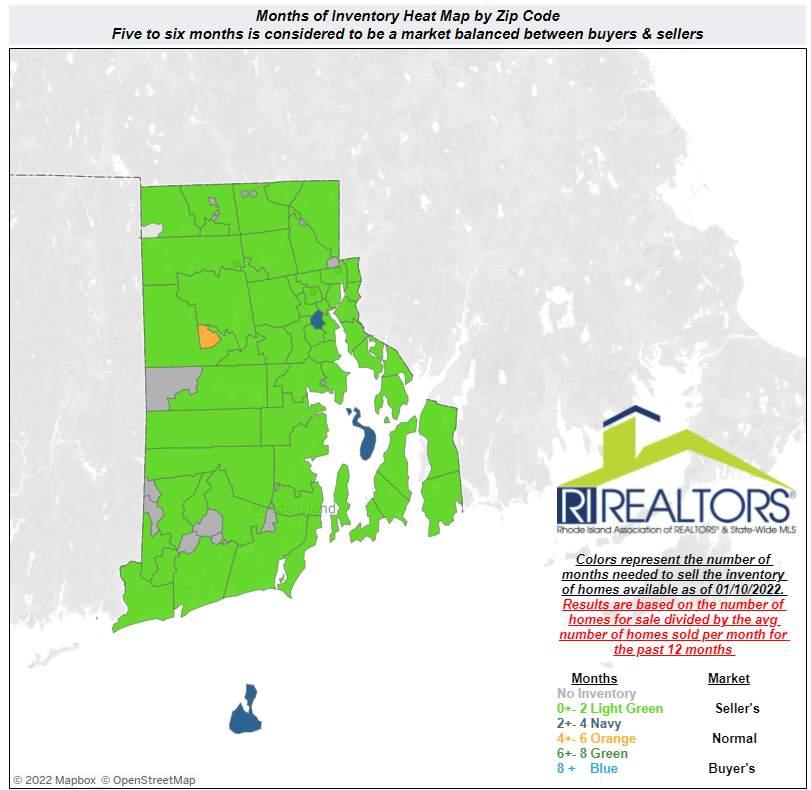
prices throughout 2021, as buyers competed for a dwindling number of homes for sale. The median price of single-family homes sold in December was 15.4 percent higher than 12 months earlier, and held steady from the prior month, at $375,000.
Most of the same trends held true for the condominium market. The median sales price of condominiums sold last month soared 24 percent year-overyear, to $309,900, owing to a 45.6 drop in inventory. The number of closings fell by 12.9 percent. Pending sales, however, increased 7.1 percent, an indication that sales could begin to rise in the first quarter of the year.
“Sales activity has slowed from 2020, but the housing market is still moving
With only 958 single-family listings on the market last month, the shortage of housing that has plagued the market in recent years, continued to create difficulties for homebuyers. While sales activity moderated slightly from a year ago, it remained strong, and prices



From
along pretty aggressively. In the latter part of 2021, we did start to see some buyers take a break from their home search, due to the intensity of competition and buyer fatigue. The expectation of higher interest rates, however, could lead many of those prospective buyers to jump back into the market, in the hopes that they can secure a home at today’s lower rates,” said Agueda Del Borgo, president of the Rhode Island Association of Realtors.
Through the end of the year, multifamily homes remained a hot commodity, due to factors like rising rents and the ability to have rental income offset the mortgage. At $390,000, the median sales price of multifamily homes in Rhode Island reached the

highest monthly price on record, rising above those of both single-family homes and condominiums.



Closed sales of multifamily homes rose 3.8 percent last month and pending sales – those sales expected to close in January or February – increased 11.1 percent. Inventory fell from January 2020 by 48 percent.
“Rhode Island’s housing market remained extremely active, right through the end of the year, and I don’t expect any significant change in the foreseeable future. The same trends are still in force – we have pent-up demand but an extremely low supply. It will take some time to see a change in direction on either end, especially in tackling how to get more inventory into the pipeline,” said Del Borgo.

 BY LUCY PROBERT
BY LUCY PROBERT
With the real estate market showing no signs of slowing down, for sellers who want to take advantage of the meteoric rise in home sales and potential buyers anxious to find a new home, renting may not seem to make good sense, but in some cases it might be the right option, says Will Milbury, owner/ broker of Milbury and Company, with offices in Westport and South Dartmouth.
“Most people choosing to sell don’t think the market is going to get much better than it is right now, but for those who own a home as an investment property and are willing to wait or want to experience the area before buying, it’s a consideration,” he says.

While some property investors choose to keep their money in real estate rather than the stock market, others hold on to their homes because of strong family attachments to the area. There are also those willing to wait and see if the market goes up even further.
“Waiting to sell can be a crapshoot,” says Milbury. “The market might still be great when you’re ready to sell in a few years, but then of course it might not be, and waiting could mean selling at a loss.”
High rent prices for summer leases is also a draw for many coastal home owners. With the summer rental market as strong as the sales market on the South Coast, renting out a second home for a month or two in July or August, for in some cases more than

$5,000 a week, can be lucrative, says Milbury. And right now the pickings are slim, with very few houses available, which makes their rental values go way up.
“And that extra money coming in can help pay for taxes and other expenses, allowing owners to enjoy their homes for the rest of the year without worrying about costs.”
An obvious negative to renting is that the home owner becomes a landlord. “Because many homes in the area are
older and require frequent maintenance, this adds a level of complication and headaches for an owner,” Milbury says.

And if the home was built before 1978, most of the time there will be an issue with lead paint, which by law must be dealt with before renting. Hiring a property manager to work with renters will help with issues like hot water and air conditioning repairs that can come up unexpectedly.
“But is it worth it?” asks Milbury. “Even a house that’s brand new within a few years will have wear and tear, with renters coming in and out.”
Why
When a couple working with Milbury wanted to purchase a home in the Dartmouth area but couldn’t find a property after a year of looking, they decided to sell their existing home, move to the area, rent for a year and wait. “They signed a lease in a community nearby that they loved, so it put them in a good position to see homes that came on the market in a moment’s
401-835-8502
traceymulveysells@gmail.com
“We get calls all of the time from people in New York, Connecticut, Boston, who come, take the tour and fall in love, but aren’t ready to plunk down a lot of money without spending a summer here first to test it out.”
WILL MILBURY
their decision on where they want to be.
notice,” he says. “We found them a beautiful, quiet property in Round Hill and closed a few weeks later. They were definitely at an advantage living so close.”
In other cases, potential buyers fall in love with the South Coast but still are hesitant to spend a large amount of money in a place they weren’t yet familiar. “We get calls all of the time from people in New York, Connecticut, Boston, who come, take the tour and fall in love, but aren’t ready to plunk down a lot of money without spending a summer here first to test it out,” says Milbury. For them, renting helps firm up
In the end, if a homeowner’s goal is to make a significant profit from their home in the short term, then in the current market, selling is their best option, says Milbury.




But for property investors who see financial advantages in the long run by staying put, or who want the flexibility of maintaining a second family home that can be enjoyed for years and generations to come, or even for those who want to dip their toe in the water and see all that the area has to offer before making what could be a major investment, renting may be their most worthwhile decision.




















It can be great for entertaining or family time to have the kitchen and living area flow into each other. It can also diminish privacy and increase noise throughout the living spaces.
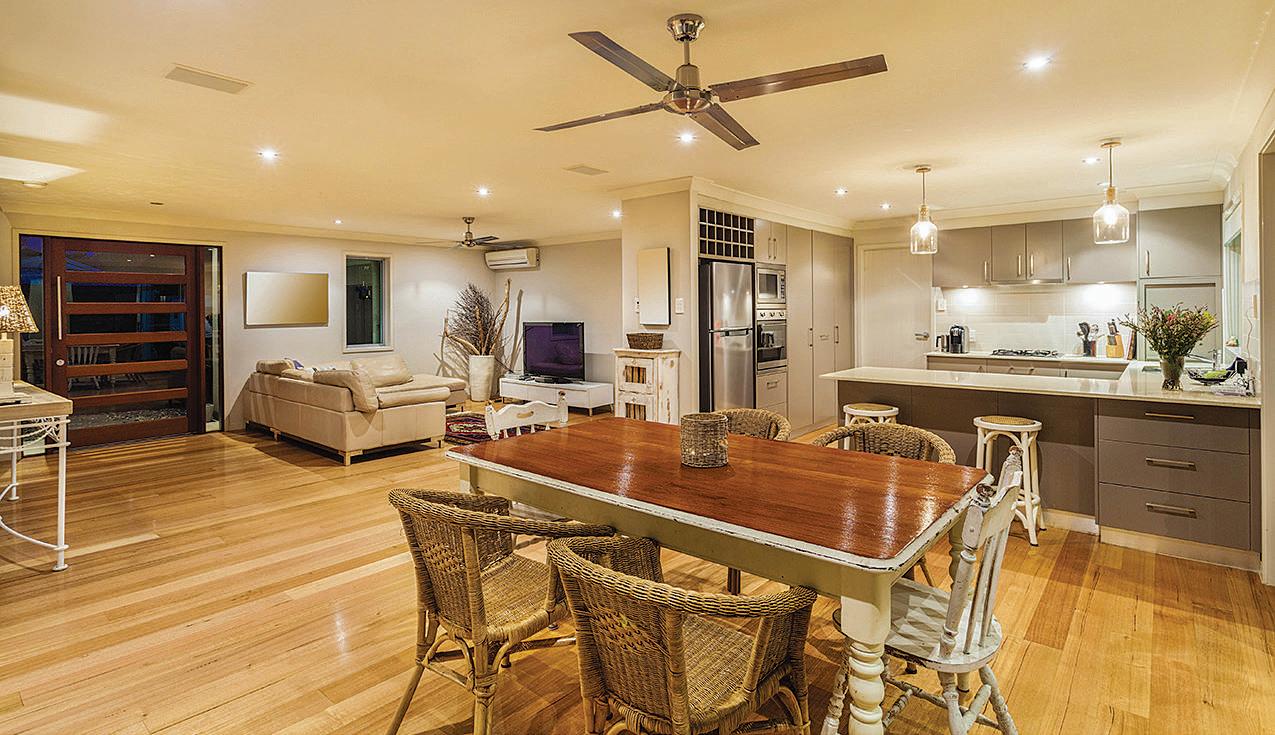
Open-concept homes have become increasingly popular in recent years. An open-concept home is one in which the rooms flow into one another with limited obstruction from walls or other barriers.
According to the National Association of Home Builders, 84 percent of new single-family homes have fully or partially open layouts.
While they may seem like a new trend, open floor plans are anything but. Early American homes featured open, often one- or two-room units built around the central kitchen/ hearth. This maximized warmth and functionality. Homes evolved as incomes grew, and soon homes had several smaller rooms with specialized functions.
What’s old has become new again. However, before diving head first into a new home purchase or a big renova-
tion to realize an open-concept dream, consider the pros and cons of this type of setup to determine if it’s really right for you.
Open floor plans facilitate the flow of natural light throughout a space and can promote air flow, helping to reduce warm or cool pockets of air in otherwise closed-off rooms.
Open homes make socializing easier, even when people are doing different things. While someone is cooking dinner in the kitchen, he or she can still interact with someone else playing video games in the family room or paying bills in the home office. Entertaining also is easier, as mingling with guests is much more convenient when walls are not getting in the way.
A smaller home can feel much larger if it employs an open concept. The
square footage is not divided into smaller quarters, which sometimes are rooms (such as formal dining rooms) that are only used a few times per year. This eliminates underused spaces and opens up sight lines in the layout.
The value of real estate has risen dramatically since the onset of the COVID-19 pandemic, and prospective buyers may prefer an open-concept plan because it can help them minimize building costs.
Open layouts are not for everyone. The same sense of space that occurs when walls are taken down may make rooms feel cavernous and less cozy, particularly in homes with ample square footage. In addition, privacy can be hard to come by when all rooms feed into one another.
When the kitchen is not separate
from the family room space, that makes it easy for noise to compromise the area’s comfort levels. There is no hiding from noise in an open floor plan, as sounds from voices, television shows and appliances tend to echo and blend together. And if the home is a single-story layout, those noises from the main living areas also may carry to adjacent bedrooms.
Smoke and smells are another thing to consider. When something on the stove spills over, a small range hood will not be practical for clearing smoke from a large space. Though the aroma of freshly cooked food is enticing, it can make it hard for cooks to keep guests out of the kitchen.
Open-concept homes are popular, but homeowners should weigh the pluses and minuses to see if this trend is truly right for them.







While the ground is still cold and spring planting is still far off on the horizon, it’s a great time to begin your outside landscape planning. Between now and the last frost around the middle of May is the time to schedule your gardening goals — especially for anyone thinking about getting their home on the market this spring.
Rick Peckham of Peckham’s Greenhouse in Little Compton shared tips on how to start planning for spring growth today.
Set goals for what you want your garden to look like when spring comes by deciding what needs to be done now, says Peckham.

“Go through your seed catalogs and see when the best time is to start planting vegetables and flowers. For instance, some may need to go in the ground six weeks before the last frost date, so you will need to count backwards from there.”
If it’s all written down early and easily accessible, you’re not using up your garden space on guesses later on, he says.
One simple midwinter project is pruning ornamental grasses that have grown too tall. “These will look like heck about now and could probably use a haircut,” says Peckham. Apple and fruit trees can also be pruned, and it’s time to walk around and inspect and clear out branches that are broken, dead or damaged by storms. When it comes to pruning shrubs, hold off, he says. The rule of thumb is to prune right after they bloom, which will not be until after the beginning of spring.
While there is no rush to pull most weeds yet, chickweed, a cool season weed which can come up in thick carpets of green among garden beds in mild winter climates, can be pulled up now.
“On warmer winter days you can see them starting to grow, and it’s a good idea to get them out of your garden,” says Peckham.
Everything is still dormant, so digging now is not a good idea, says Peckham. “Wait until the soil warms up a bit before you start breaking ground. The more you dig, the worse it is for the ecosystems and beneficial insects beneath the ground, so keep it as is for a while.”
As you get into April, that’s the time to begin moving perennials around in their beds, as well as fertilizing before planting shrubs and vegetable gardens.
When it comes to cleaning debris around shrubs and plants, Peckham recommends holding off for a while.
“There seem to be two thoughts when it comes to cleaning up,” he says.
“There are those who do a big cleanup in the fall and then mulch so it looks neat for the winter, and then there are those like myself who think a better plan is leaving the debris where it lies, providing a natural ground cover and insulation, as well as a place for birds and other little animals to hide, and then do a big cleanup before the new growth happens.”
Although they’re typically not in use until around June when temperatures are higher, make sure your irrigation system is up and running well before then by checking for leaks and replac-
Most people feel compelled to do a big fall cleaning that removes all the fallen leaves and debris. A local landscaping expert prefers to wait until the spring. He says the leaves provide natural ground cover and insulation through the winter and can be cleaned in the spring when everything comes back to life.

ing damaged above-ground hoses as well.
In the end it’s all about the planning, says Peckham: “Midwinter is not too early to figure out what you want to
accomplish in your garden.” That way when spring is in full bloom and the ‘For Sale’ sign goes up, your home looks its beautiful, bursting-withbeauty, best.

An inviting, well-tended landscape can add significant curb appeal to a home. Such a landscape also can serve as a point of pride and welcome homeowners each evening as they arrive home from work.
Landscaping projects run the gamut from simple changes that can be accomplished on a weekend afternoon to more significant and costly undertakings that require the work of a professional. Budget-conscious homeowners may be looking for simpler projects, and the following are some less costly ways to upgrade a landscape.
Awe-inspiring colors can make a landscape stand out from surrounding properties. Flowers, bushes and plants may be the first thing homeowners consider when trying to add color to
their lawns, but planters can provide a more immediate way to give exterior grounds some color.
Bold planters won’t lose their color in a matter of weeks like many flowers do, and homeowners can switch planters so the colors align with the season. For example, some pastel planters can evoke the spirit of spring, while orange planters can be filled with mums to give a landscape an autumnal feel.
Well-maintained perennials grow back each year, making them ideal for homeowners who don’t have the time
or desire to map out new gardening arrangements each spring. Planting perennials also is a great way to add color around the property without breaking the bank.
Though it’s more expensive than adding planters and planting perennials, upgrading old and cracked walkways is a great way to give a property a whole new look. According to the renovation experts at HomeAdvisor, homeowners typically pay between $6 and $12 per square foot for new concrete walkway installation.
Homeowners working on a budget can target spots where walkways have already cracked and fix those areas first before continuing the project piecemeal until all the old walkways have been replaced.

privacy
Homeowners spent more time at home than ever before during the pandemic, and some might have grown tired of seeing what their neighbors are up to. Fencing might be the first solution homeowners consider when looking to make their landscapes more private. But new fencing installation can be expensive, costing homeowners between $1,667 and $4,075 on average, according to BobVila.com. A more costly and natural solution is to plant trees around the perimeter. Speak with a local landscaping professional, who can survey the property to see which trees might thrive and provide the privacy homeowners want. Creating an inviting landscape doesn’t have to break the bank. Various small and relatively inexpensive projects can change the look and feel of a home’s exterior.

A new walkway is a small project that can still offer a significant upgrade over a home’s existing landscape.

Spring is the season for fixing up a home. Homeowners who aren’t interested in doing the work themselves turn to contractors to ensure the job is done not only to code, but on time and efficiently.
After receiving an initial estimate from a contractor, homeowners may wonder if there is any additional wiggle room in contractors’ costs.
Certain contractors are willing to negotiate while others are firm in their prices. However, learning the basics of negotiation can put homeowners in position to save money on dream renovations.
Getting the best price typically require shopping around and not settling on the first bid. Experts recommend getting at least three estimates on the same job — and be sure to let each contractor know that you are soliciting multiple bids. This alone may
entice a specific contractor to give you his or her best offer up front. Avoid simply choosing the lowest bid. Look at quality of work, reputation and reviews. If you like a costly contractor more than another, see if that contractor is willing to match a lower bid to win the job.
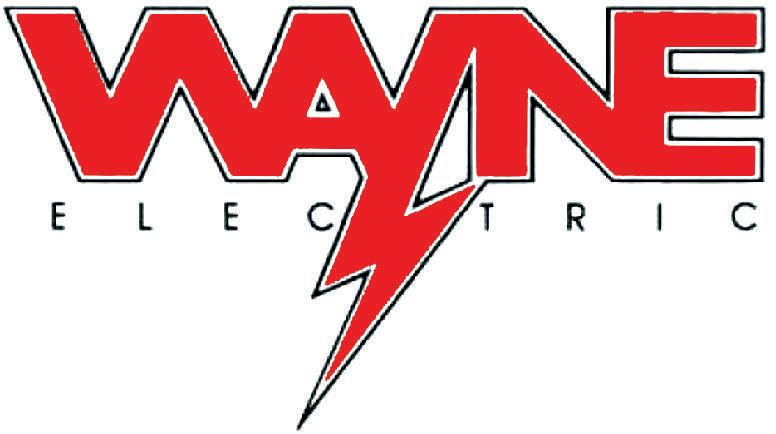
As with other industries, home renovation work heats up during certain seasons or times of year. General contractors may be more willing to negotiate for a lower price depending on when their busy season may be. Jobs may slow down in winter, for example.
Even after getting a good bid, you may be able to speak with your contractor about lowering costs even more by choosing less costly supplies. Find out if contractors can source materials from a low-cost supplier. In addition, discuss if you can purchase your own supplies.
Be honest with the contractor about your budget and figure out if there is any way for you to do some of the work to lower costs. The contractor can give you jobs that are within your abilities, which can shave dollars off the final price.
Understand the laws governing contract language in your state or province. Contracts should also spell out the change order process so that expectations of changes and costs will be known in advance. These are just some of the tactics homeowners can use when negotiating the price of home remodels or improvements.
There are simple ways to make your home’s living spaces more livable
Home improvement projects require substantial financial investment. But just because a homeowner wants to bring a fresh look indoors doesn’t mean he or she has to break the bank along the way.

Living rooms are some of the most frequently used spaces in a home, and they can use an update from time to time to stay on trend or to make the area more functional for a changing family dynamic. Here are some budget-friendly ideas for breathing new life into living room designs.
Homeowners should figure out how many dollars they can designate to a living room makeover before purchasing supplies or hiring out the work. Figure out the scope of the remodel, visit stores or suppliers to price out materials, get estimates from contractors, and then plan for
some unforseen circumstances along the way to determine if this type of renovation is affordable. If not, scale things back until the project more closely aligns with your budget.
Change
Lighter and brighter colors are on trend. A can or two of paint can do wonders for updating a space without a large financial commitment. Pair that new paint color with new window coverings and complementary throw pillows to pull the theme together with minimal expense.
Update
Tired, outdated carpeting or other flooring can use an overhaul. While solid hardwood flooring may be preferable, there are many types of laminate flooring that mimic the looks of popular wood colors and styles for a fraction of the cost. Plus, many are sold at home improvement retailers and even at warehouse clubs or online for rea-

upholstery or even a slipcover can update designs.
sonable prices. Laminate flooring also may be a potential DIY job for a skilled homeowner, saving even more money.

Fireplaces were once hot commodities, but that popularity waned in the 1970s and 1980s. Homeowners with chimneys may discover a fireplace was boarded over and the bare bones still exist that can be renovated to bring back character. There also are ventless freestanding units that are quite affordable that can mimic the look of a built-in fireplace.
There’s no need to throw away quality furniture if the fabric is the only thing impeding design. New
Rather than adding something to the living room, remove clutter to give the room a more airy feel. This can instantly change the look of the room. Use cord covers to tame plugs for electronics and remove unnecessary furniture from the room.

Another easy and often inexpensive fix is to change lighting fixtures, including using brighter, more energy efficient LED bulbs, and to assess lighting needs to eliminate dark corners of rooms that can make the space seem drab.
Living room spaces in need of an update often can benefit from improvements that go easy on the wallet.
This chateau-style home in the exclusive Nayatt Point neighborhood sits on 4 waterfront acres overlooking Narragansett Bay.

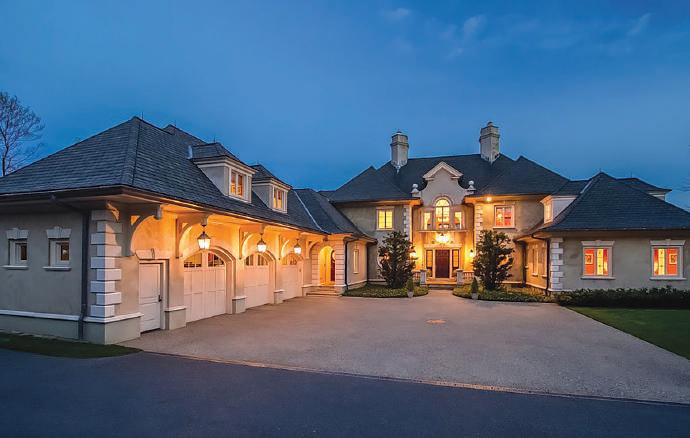
Buyer represented by: Ray Mott, Mott & Chace Sotheby’s

and
• 2.78 acres
• Seller represented by: Patricia Orsi, William Raveis
• Buyer represented by: LeAnne West, Gustave White Sotheby’s

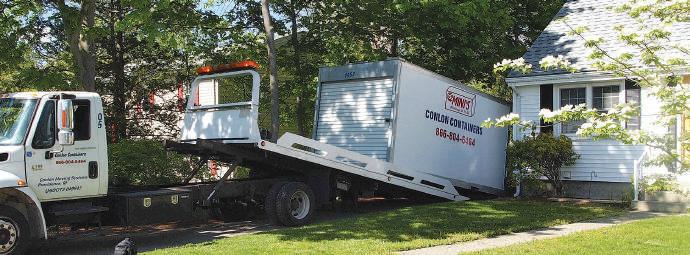
Built circa 1767, this stately Colonial is elegant, historic, charming and lavish to today’s standards. It has more than 5,000 square feet of space and sits on more than an acre of land in one of Rumford’s top neighborhoods.

• $1,245,000
• 4 beds
• 3.5+ baths
• 1.26 acres
• Seller represented by: Patty Bain, RE/ MAX River’s Edge
• Buyer represented by: Paula Morrison, Residential Properties


This magnificent home was designed by renowned architect, Maryann Thompson of Cambridge, Mass., and built to a very high standard in 2015. The well-designed floor plan offers comfortable living featuring a great room, chef's kitchen, 4 ensuite bedrooms, 2 family rooms for privacy and/or media use — all with spectacular views of the Atlantic Ocean and Long Pond. A separate surf hut includes a half bath, sauna, and outdoor showers.

• $4,882,733
• 4 beds
• 4.5 baths
• 3,530 sq. ft.
• 1.85 acres
• Seller represented by: Deborah Ladd, Lila Delman
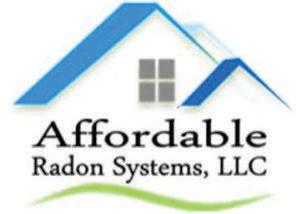
• Buyer represented by: Renee Welchman, Welchman R.E. Group

This exclusive home on one of the most exclusive streets in the region has more than 6,000 square feet of living space, accompanied by a pool, hot tub and sauna.

$4,100,000

represented by: Lisanne Morrison, Coldwell Banker
Fogbottom Farm, one of Tiverton's most iconic historic estates, sits on nearly 5 acres of farm coast grounds with breathtaking, panoramic views of the Atlantic Ocean. The property features a circa-1808 home, guest house and barn, along with native stone walls, rolling green lawns, and priceless landscaping. • $3,270,000 • 5 beds

• 4.7 acres
• Seller represented by: Cherry Arnold, Mott & Chace Sotheby’s
• Buyer represented by: Rebecca Rubin, Residential Properties

This western-facing waterfront home in the Touisset area includes a dock and mooring. The immaculately maintained shingled cottage features a floor plan designed to capture breathtaking water views from every room. The first floor features a spectacular great room with open layout living and dining areas anchored by a magnificent fireplace.


• $1,387,500
• 3 beds
• 2.5 baths
• 3,770 sq. ft.
• .39 acres
• Seller represented by: Beth Anderson, Mott & Chace Sotheby’s
• Buyer represented by: Kirk • Shryver, Residential Properties
This waterfront home has breathtaking unobstructed southwesterly views of the Westport River and beyond. This property includes more than an acre of land that rolls gently to the river's edge. The home was custom designed with interesting architectural elements taking advantage of the natural light and views of the river.
• $3,650,000
• 3 beds
• 4 baths
• 3,736 sq. ft.
• 1.16 acres


• Seller represented by: Liz Kinnane, Mott & Chace Sotheby’s
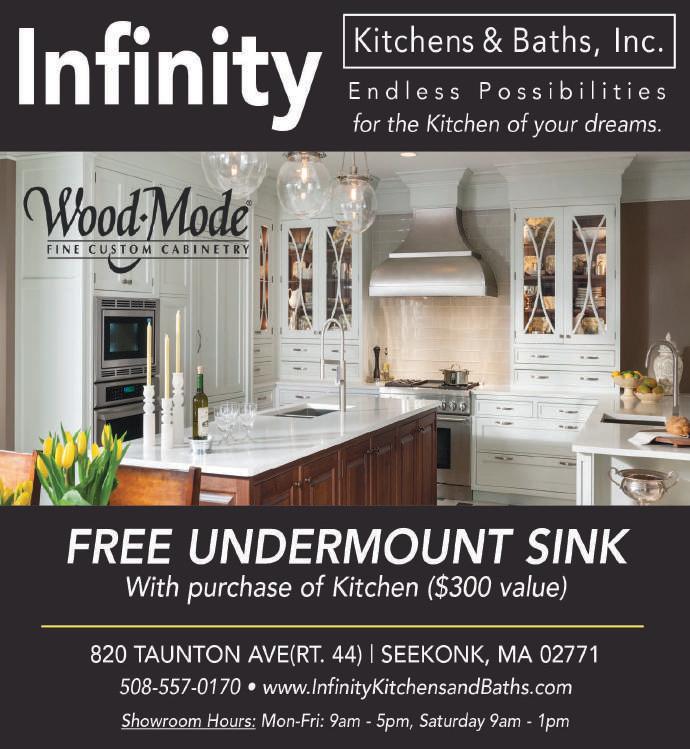
• Buyer represented by: James Sabra, Equity Real Estate
Ramon Reyes champions the trees, landscapes and property investments of the customers in his care. And he’s one of the many reasons we’ve become the premier scientific tree and shrub care company in the world 877-BARTLETT | bartlett.com

My mantra is an ounce of prevention will save a whole tree.

Remote working has become popular in recent years, but the “workingfrom-home” economy bloomed exponentially as the world was forced to confront the COVID-19 pandemic. According to Stanford economist Nicholas Bloom, as of summer 2020, 42 percent of the United States labor force was working from home full-time.
The need for home office spaces has increased as more people work from home. Many people have retrofitted various spaces around their homes into areas to get work done. More organized home work spaces can increase productivity. Individuals can follow these guidelines to create effective, organized home offices.


The desk is the primary spot where work will take place. The right desk accessories can provide visual appeal and also serve practical purposes. Have cups for holding pens and pencils, baskets and bins for larger items, and store whatever you can elsewhere so it does not lead to clutter on the desk. Store wireless printers in a cabinet or even on a bookshelf so it doesn’t take up real
estate on the desk.

Create a printing station
While you’re moving that wireless printer elsewhere, designate a space to serve as the central printing hub. This way children who need to print assignments for school will know where to go as well. Printer supplies like extra ink cartridges and printer paper can be kept in decorative storage boxes near-
by.

Shelving can help keep items organized and off the desk in home offices without closets or drawers. Look for shelves that blend in with decor but are sturdy enough to be functional.
Figure out a system that works for

you to help tidy up papers you choose to save. While some papers can be scanned and stored as digital files, color-coded file folders can organize statements and other important documents. This makes it easy to find the folder you need when looking for certain documents.
Establish a charging station
Repurpose certain items, such as a desk organizer, into an easily accessible electronics charging station where phones and tablets can charge at one time.
Make essential binders
HGTV suggests making binders that can store the most important papers for easy access — even in an emergency. Set up a binder for automotive paperwork, including repair receipts, a medical binder where key medical records are kept, a binder for manuals for devices in the home, and one to store financial planning documents. These organizational tips can help remedy common problems around a home office.




